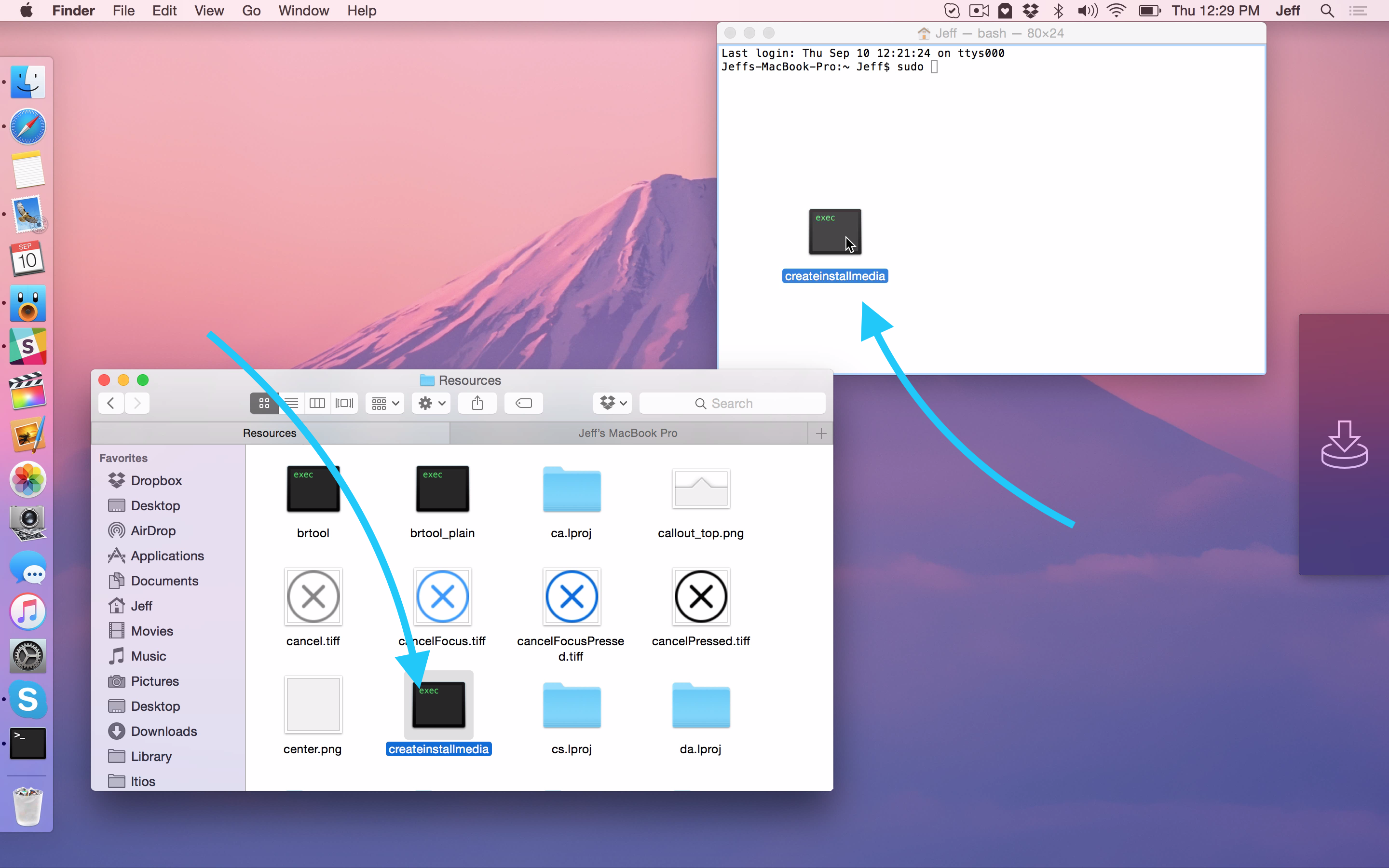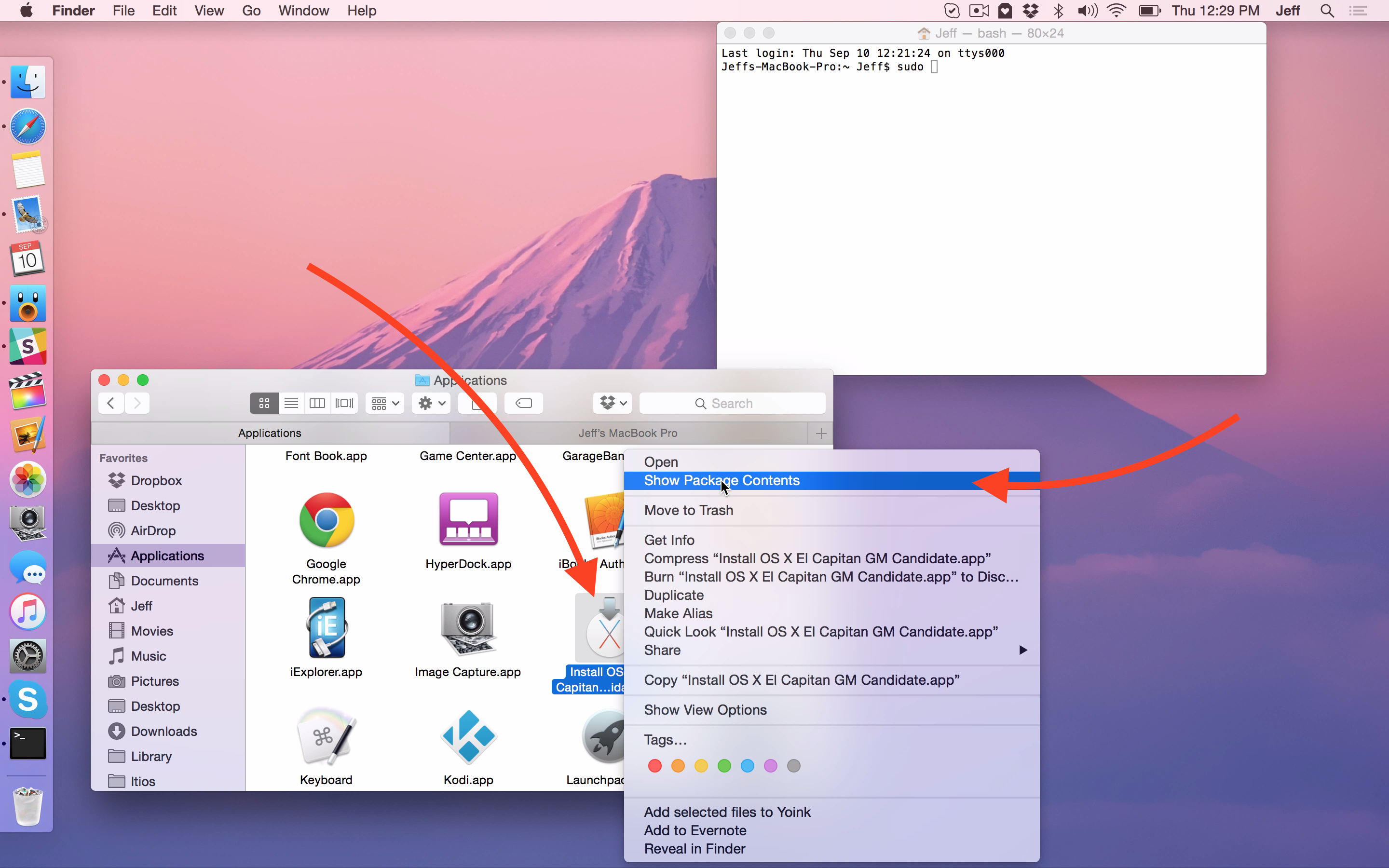- Create Usb El Capitan Installer
- Create Usb El Capitan Dmg
- El Capitan Usb Boot
- Make El Capitan Install Usb
Apple has now made the El Capitan file from their website into a.dmg file. In order to use this file to create a bootable drive, you must do these steps before you are able to use the createinstallmedia command. Step 1: Obtain the El Capitan file from Apple as mentioned above. Step 2: Run and mount the InstallMacOSX.DMG file. OS X El Capitan PWN: Uploading.TransMac: Uploading. Method 1: Using TransMac Download TransMac's latest version for Windows from this link. Connect your USB drive Right Click on your USB drive option in TransMac and select Format Disk for Mac After that, right-click the USB Drive and select Restore with Disk Image Point to your Mac OS.dmg or.iso. These instructions work to create a bootable install disk for all versions of macOS from macOS 11 Big Sur back to OS X El Capitan 10.11. What’s needed to create a bootable install disk A USB flash drive or other secondary volume formatted as Mac OS Extended, with at least 14GB of available storage. Currently, you can only create a bootable installer for macOS Big Sur, Catalina, Mojave, High Sierra, or El Capitan. If you want to go back to your previous macOS, here's how to downgrade macOS.
Create Usb El Capitan Installer
Mac operating system’s twelfth major version is the El Capitan Installer (version 10.11). All the Mac computers which don’t have the privilege to upgrade to MacOS High Sierra or the computers that need to upgrade to El Capitan first, can download this twelfth version on the computer. This is the very last version of the Mac operating system which comes under the name OS X. And it is named as ‘El Capitan’ after the formation of a rock in the Yosemite National Park. El Capitan Installer is the post version to the Yosemite, and it was built by adding up more improvements to the Yosemite. In this version of the Mac operating system, the Apple Inc. has focused on the performance, stability, and security of the computer. Anyone who is interested can download it on the Mac PC.
How to download El Capitan Installer?

If you want to upgrade to OS X El Capitan, first you have to collect gather your Mac PC and then download the El Capitan Installer. That’s what we are going to do now.
- Go to the App Store and open the El Capitan page there.
- Then you must click on the ‘Download; button on the El Capitan Page.
- If your Mac PC is compatible to perform this upgrade, a file named ‘Install OS X El Capitan’ will download to your Applications folder.
- The installer will open automatically after finishing the download process. All you have to do next is click on the ‘Continue’ button and follow the onscreen instructions.
Mac OS X Leopard (version 10.5) is the sixth major release of macOS, Apple's desktop and server operating system for Macintosh computers. Leopard was released on October 26, 2007 as the successor of Mac OS X 10.4 Tiger, and is available in two editions: a desktop version suitable for personal computers, and a server version, Mac OS X Server. Confirm that the USB drive will lose it’s data and enter the Admin password when asked; Disk Utility will now create a bootable OS X Mountain Lion installer drive out of USB drive using the disk image, this can take a little while depending on how fast the drive and Mac are but 20-30 minutes isn’t unusual. El Capitan Installer. Mac operating system’s twelfth major version is the El Capitan Installer (version 10.11). All the Mac computers which don’t have the privilege to upgrade to MacOS High Sierra or the computers that need to upgrade to El Capitan first, can download this twelfth version on the computer.
Upgrade Mac OS Version with El Capitan Installer while Protecting your Data
Before executing the Upgrade, you must prepare the Mac PC for the El Capitan Update. For that, gather these requirements first.
- The Mac PC must have at least 2GB of memory and 8.8GB of storage space.
- The PC must have at least 45% of battery life.
- Connect the Mac PC to Wi-Fi or any other internet connection.
- The Mac Apps must be up to date with the latest versions.
- Take backups of all your personal data and present OS of the Mac PC.
Important! It is very important to backup your important data on the Mac PC to an external storage device because it will help you to avoid the data loss issues. Acapella app for macbook pro. If any case, you forgot to backup the data, your data may be lost while executing the El Capitan Installer update. So make sure you make a backup of the device data.
How to use El Capitan Installer for a Clean Install?
01. El Capitan Clean Install on Empty Volume with El Capitan Installer
Create Usb El Capitan Dmg
This is the easiest method for the clean install. Here, you can install the OS X El Capitan Installer onto an empty volume, or you can use a storage space that has the content which no longer needed and don’t mind removing. What it matters here is that you don’t use the current startup volume as the destination here. What makes this method easier is the fact that it is possible to perform this clean install while booted from the current startup drive. You don’t need a special, custom-made startup environment for the empty volume clean install. All you have to do is, start up the installer and go.
02. El Capitan Clean Install on Startup Volume with El Capitan Installer
This is the most common method of the two. Usually, the clean install process deletes the contents of the destination drive. Therefore, if you choose the startup drive method to perform the clean install of El Capitan Installer, you have to follow some extra steps as well.
- First, you have to create a bootable USB flash drive that has the Installer of OS X El Capitan.
- Then erase the startup drive.
- After then, start the clean install process.
How to Create El Capitan Installer with USB?
Requirements
- The USB flash drive must be at least 8GB
- El Capitan Installer must be on the Mac PC’s Applications folder.
Process

- Plug the USB drive into the Mac PC with the Installer of the El Capitan on it.
- Rename the USB driver using an easy to remember and use name. (For the ease of the steps ahead, I will rename it as ‘ElCaptIns’)
- Be sure that the Installer of the El Capitan named ‘Install OS X El Capitan.app’ is in its default location (Applications folder).
- Select and copy the text of the below-mentioned terminal command.
- Now you can launch the terminal in the Applications/Utilities/
- In this step, it deletes the data in the destination drive. So make sure it doesn’t contain any valuable data and paste the copied command into the terminal, then press ‘Return’.
- When the windows prompted, enter the admin level account password of yours and press to Return.
- Then a message telling “To continue we need to erase the disk at /Volumes/ElCaptIns. If you wish to continue, type (Y) then press return:” will emerge. You can type ‘Y’ and press to return to continue. You are already set if you don’t see this message.
sudo/Applications/InstallOSXElCapitan.app/Contents/Resources/createinstallmedia --volume /Volumes/ElCaptIns --applicationpath /Applications/Install OS X El Capitan.appUSB installer and El Capitan Installer in Apple Store
El Capitan Installer is only available in the Mac App Store. So you can only download it from the App Store. By the way, having a USB installer to perform the El Capitan is a good idea. Because having a copy of the OS version in a separate device ensures that you always have a backup plan to install it or re-install it on the PC. When you have the USB installer with the El Capitan Installer in it, you no longer need the internet connection or the access to the Mac App Store to perform the upgrade.
What is createinstallmedia?
“createinstallmedia” is a unix program hidden inside the OS X Installer which is provided by the Apple Inc. to create a bootable installer drive. createinstallmedia is the ideal and the easier to use tool if you are comfortable to use the terminal. This is only available for the OS versions of Lion (OS X 10.7) and above.
Make Os X El Capitan Bootable Usb Drive
System and Hardware Requirements for El Capitan Installer
System Requirements
- iMac models from mid 2007 or later
- MacBook models from late 2008 or later
- MacBook Pro models from mid 2007 or later
- MacBook Air models from late 2008 or later
- Mac mini models from early 2009 or later
- Mac Pro models from early 2008 or later
- Xserve models from early 2009
Hardware Requirements
- OS X v10.6.8 or later
- 2GB of memory
- 8.8GB of available storage
- Some features require an Apple ID (terms apply)
- Some features require a compatible Internet service provider (fees may apply)
FAQs:-
01. What is the best method to install El Capitan?
You can either use the default method to upgrade install or clean install methods to get El Capitan Installer but, without any doubt, Clean Install is the best method to upgrade your Mac OS. I hope all the above facts prove that.
02. How to save previous data when upgrading the OS X?
Simply, take a backup by using the Time Machine.
- Open the Time Machine app.
- Click on the ‘Select Backup Disk’.
- Select the external drive or internal location where you want to save the files.
- Click on the ‘On’ to turn on the Time Machine.
- Click on the Arrow Clock icon in the Finder Bar at the top of your screen and select ‘Backup Now’.
03. Is it secure to install El Capitan without Apple Store?
Make Os X El Capitan Bootable Usb Reader
No, it is not safe to get El Capitan Installer outsider of the Apple Store. It is only safe to get this OS upgrade from the Mac App Store. Besides, there is no such external place to get this OS upgrade. I have provided the steps to install El Capitan in the above of this site. Just follow those steps and upgrade your Mac PC to the El Capitan.
- Download Mac OS EL Capitan 10.11 latest version; How to create Bootable USB for Mac OS El Capitan on Windows; How to Install Mac OS X El Capitan on Virtualbox on Windows; Steps to Install Mac OS X El Capitan on VMware on PC. Before going to start creating a new Virtual machine for Mac OS X El Capitan you need to install unlocker for VMware.
- If you wanna create bootable USB flash drive for Mac OS X El Capitan on Windows PC. You need a TransMac Software. That’s not a problem if you use a computer that supports legacy or UEFI. Just you need TransMac and El Capitan dmg file. Siddharth choubisa September 20, 2016 at 3:43 PM.
Catalina 32 bit. These advanced steps are primarily for system administrators and people who are familiar with the command line. You don't need a bootable installer to upgrade macOS or reinstall macOS, but it can be useful when you want to install it on multiple computers without having to download the installer each time.
What you need to create a bootable installer
- A USB flash drive or other secondary volume, formatted as Mac OS Extended, with at least 12 GB of available storage
- A downloaded installer for macOS Big Sur, Catalina, Mojave, High Sierra or El Capitan
Download macOS
- Download: macOS Big Sur, macOS Catalina, macOS Mojave or macOS High Sierra
These will be downloaded to your Applications folder as an app called Install macOS [version name]. If the installer opens after download, quit it without continuing the installation. To get the correct installer, download from a Mac that is using macOS Sierra 10.12.5 or later, or El Capitan 10.11.6. For enterprise administrators, please download from Apple, not a locally hosted software update server. - Download: OS X El Capitan
This will be downloaded as a disk image called InstallMacOSX.dmg. On a Mac that is compatible with El Capitan, open the disk image and run the installer within, which has the name InstallMacOSX.pkg. It installs an app named Install OS X El Capitan into your Applications folder. You will create the bootable installer from this app, not from the disk image or .pkg installer.
Use the 'createinstallmedia' command in Terminal

El Capitan Usb Boot
Select the type of disk being used. Note that if you’re using a 8GB (or larger) USB thumb drive, it will be completely erased. DiskMaker will erase any complete volume that you signify, so if you wish to make a disk that can install Yosemite, El Capitan, and Sierra, consider using Disk Utility (found in the Applications/Utilities folder) to partition the drive into three separate volumes. How To: Create a Bootable Install USB Drive of Mac OS X 10.10 Yosemite How To: Change OS X’s Annoying Default Settings Using Terminal How To: Dual Boot Mac OS X 10.11 El Capitan & 10.10 Yosemite How To: Create a Bootable Install USB Drive of Mac OS X 10.11 El Capitan.
- Connect the USB flash drive or other volume that you're using for the bootable installer.
- Open Terminal, which is in the Utilities folder of your Applications folder.
- Type or paste one of the following commands in Terminal. These assume that the installer is in your Applications folder and MyVolume is the name of the USB flash drive or other volume you're using. If it has a different name, replace
MyVolumein these commands with the name of your volume.
Big Sur:*
Catalina:*
Mojave:*
High Sierra:*

El Capitan:
Make El Capitan Install Usb
* If your Mac is using macOS Sierra or earlier, include the --applicationpath argument and installer path, similar to the way this was done in the command for El Capitan.
After typing the command:
- Press Return to enter the command.
- When prompted, type your administrator password and press Return again. Terminal doesn't show any characters as you type your password.
- When prompted, type
Yto confirm that you want to erase the volume, then press Return. Terminal displays the progress as the volume is being erased. - After the volume has been erased, you may see an alert stating that Terminal would like to access files on a removable volume. Click OK to allow the copy to proceed.
- When Terminal says it's finished, the volume will have the same name as the installer you downloaded, such as Install macOS Big Sur. You can now quit Terminal and eject the volume.
:max_bytes(150000):strip_icc()/Terminallaunch-ad6d90df7d5c4de1a5f2dea28709bbae.jpg)
Use the bootable installer
Determine whether you're using a Mac with Apple silicon, then follow the appropriate steps:
Apple silicon
- Plug the bootable installer into a Mac that is connected to the Internet and compatible with the version of macOS you're installing.
- Turn on your Mac and continue to hold the power button until you see the startup options window, which shows your bootable volumes and a gear icon labelled Options.
- Select the volume containing the bootable installer, then click Continue.
- When the macOS installer opens, follow the onscreen instructions.
Intel processor
- Plug the bootable installer into a Mac that is connected to the Internet and compatible with the version of macOS you're installing.
- Press and hold the Option (Alt) ⌥ key immediately after turning on or restarting your Mac.
- Release the Option key when you see a dark screen displaying your bootable volumes.
- Select the volume containing the bootable installer. Then click the up arrow or press Return.
If you can't start up from the bootable installer, make sure the External Boot setting in Startup Security Utility has been set to allow booting from external media. - Choose your language, if prompted.
- Select Install macOS (or Install OS X) from the Utilities window, then click Continue and follow the onscreen instructions.
Learn more
For more information about the createinstallmedia command and the arguments that you can use with it, make sure the macOS installer is in your Applications folder, then enter the appropriate path in Terminal:
- Big Sur: /Applications/Install macOS Big Sur.app/Contents/Resources/createinstallmedia
- Catalina: /Applications/Install macOS Catalina.app/Contents/Resources/createinstallmedia
- Mojave: /Applications/Install macOS Mojave.app/Contents/Resources/createinstallmedia
- High Sierra: /Applications/Install macOS High Sierra.app/Contents/Resources/createinstallmedia
- El Capitan: /Applications/Install OS X El Capitan.app/Contents/Resources/createinstallmedia
El Capitan Create Bootable Usb Windows
A bootable installer doesn't download macOS from the Internet, but it does require an Internet connection to get firmware and other information specific to the Mac model.